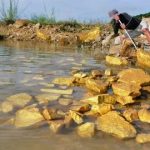Gold mining has long been a lucrative and essential industry, providing the precious metal for a wide range of applications. As technology and innovation continue to advance, the future of gold mining is full of exciting potential. In this article, we will explore the possibilities for unlocking this potential and the implications for the industry. Join us as we delve into the future of gold mining and the opportunities that lie ahead.
Unlocking the Potential: The Future of Gold Mining is a comprehensive report that delves into the various factors that will shape the future of the gold mining industry. The report covers topics such as technological advancements, sustainability efforts, market trends, and geopolitical considerations. It also offers insights into potential challenges and opportunities that may arise in the years to come for gold mining companies. The report aims to provide a clear understanding of the shifting landscape of the gold mining industry and to assist industry stakeholders in making informed decisions for the future.
The History of Gold Mining: From Ancient Civilizations to Modern Techniques

The history of gold mining spans thousands of years, with evidence of the precious metal being utilized by ancient civilizations such as the Egyptians, Romans, and Incas. Gold has long been prized for its rarity and beauty, leading to the development of sophisticated mining techniques by these early societies.
In ancient Egypt, gold was mined along the Nile River and in the deserts, with evidence of mining activities dating back to around 4000 BC. The Egyptians utilized simple tools and manual labor to extract gold from the earth, often with the help of slaves or prisoners.
The Romans, known for their engineering prowess, developed more advanced mining techniques, such as hydraulic mining and the use of water-powered machines to extract gold from the earth. They also employed large-scale mining operations with the use of slave labor to meet the demand for gold in their expansive empire.
In the Americas, the Inca civilization also engaged in gold mining, with evidence of intricate gold artifacts and the remnants of mining operations found in regions such as Peru and Ecuador.
Fast forward to modern times, and gold mining has evolved significantly with the introduction of advanced technologies and machinery. Large-scale mining operations now utilize heavy machinery, such as excavators and dynamite, to extract gold from deep within the earth. Chemical processes such as cyanide leaching are also employed to separate gold from ore.
Environmental and social concerns have become increasingly important in modern gold mining, leading to the development of more sustainable and responsible mining practices. Measures such as reclamation and restoration of mining sites, as well as community engagement and development, are now integral parts of the gold mining industry.
Overall, the history of gold mining is a testament to human ingenuity and the enduring allure of this precious metal. From ancient civilizations to modern techniques, the pursuit of gold continues to be a driving force in global mining operations.
Environmental Impact of Gold Mining: Balancing Resource Extraction and Conservation

Gold mining can have significant environmental impacts, including deforestation, soil erosion, and the contamination of water sources with toxic chemicals such as mercury and cyanide. Miners often clear large areas of forests to access gold deposits, leading to loss of biodiversity and habitat destruction for wildlife. Additionally, the use of heavy machinery and explosives can cause soil erosion and disrupt local ecosystems.
In addition to physical disturbances, the use of toxic chemicals in the extraction process can have long-term consequences for the environment. Mercury and cyanide, commonly used in gold extraction, can leach into nearby water sources, contaminating the water and posing a threat to aquatic life and human health. This pollution can have far-reaching effects on downstream communities and ecosystems.
To mitigate these impacts, it is essential to implement responsible mining practices and strict environmental regulations. This may include using alternative, less harmful extraction methods, reclamation of mining sites, and the implementation of proper waste management practices. It is also crucial to involve local communities and indigenous groups in decision-making processes to ensure that their rights and environmental concerns are taken into account.
Balancing resource extraction with environmental conservation requires a comprehensive approach that considers the long-term effects on the environment and local communities. By prioritizing sustainable practices and environmental protection, it is possible to minimize the environmental impact of gold mining while still meeting the demand for this valuable resource.
The Economics of Gold Mining: Trends, Challenges, and Opportunities

The economics of gold mining involves various trends, challenges, and opportunities. Gold mining industry is affected by economic conditions, geopolitical factors, and technological advancements. In recent years, there has been an increasing trend towards sustainable and responsible mining practices, as well as greater emphasis on environmental and social impact assessments.
Challenges facing the gold mining industry include fluctuating gold prices, rising production costs, and declining ore grades. These factors can impact the profitability of gold mining companies and affect their ability to generate positive returns.
On the other hand, there are also opportunities in the gold mining sector, such as the discovery of new deposits, advancements in mining technologies, and the growing demand for gold in emerging markets. Additionally, gold mining companies have the potential to diversify their operations and expand into related industries, such as exploration, development, and production of other precious metals.
Overall, the economics of gold mining is influenced by a complex set of factors, and companies operating in this sector must carefully navigate these challenges and leverage opportunities to remain competitive and sustainable in the long term.
Technology and Innovation in Gold Mining: Advancements and Potential

Technology and innovation have significantly transformed the gold mining industry, leading to improved efficiency, safety, and environmental sustainability. One of the key advancements is the use of automated and remote-controlled machinery, which reduces the need for human labor in hazardous environments. Additionally, advanced sensors and imaging technologies have enabled more accurate exploration and drilling, resulting in higher yields and lower operational costs. Furthermore, innovation in processing methods, such as bioleaching and carbon-in-pulp technology, has enhanced the extraction of gold from ore while minimizing the environmental impact. Looking ahead, the potential for further technological advancements in areas such as robotics, artificial intelligence, and data analytics promises to revolutionize the gold mining industry, making operations even more efficient and sustainable.
Regulatory Challenges in Gold Mining: Navigating Laws and Policies
See also: metal detector price
Regulatory challenges in gold mining typically involve navigating a complex web of laws, policies, and regulations at both the national and local levels. This can include obtaining necessary permits, complying with environmental and safety regulations, and negotiating with government agencies and local communities. Mining companies must also be aware of and adhere to changes in laws and policies, as well as manage potential conflicts between different regulatory frameworks. Additionally, the political and economic climate in a particular country can impact the regulatory environment for gold mining, creating further challenges for companies operating in this industry.
The Geology of Gold Mining: Understanding Deposits and Exploration
Social Responsibility in Gold Mining: Community Relations and Development
Social responsibility in gold mining entails building positive and mutually beneficial relationships with local communities. This involves promoting community development through infrastructure projects, education, healthcare, and job creation, as well as ensuring fair labor practices and environmental stewardship. Gold mining companies are also expected to engage in transparent and respectful communication with community members and to consult with them on matters that may impact their well-being and livelihoods. Additionally, fostering strong community relations helps in earning and maintaining the social license to operate, which is essential for the long-term sustainability of gold mining operations.
Investing in Gold Mining: Risks, Rewards, and Market Trends
Investing in gold mining can be a high-risk, high-reward endeavor. Risks include fluctuations in the price of gold, operational inefficiencies, and environmental and political challenges. Market trends can also impact the profitability of gold mining investments, as demand for gold can be affected by economic and geopolitical factors.
However, the rewards of investing in gold mining can be significant, particularly if the price of gold increases or if the mining company is able to operate efficiently and effectively. Additionally, gold mining investments can provide a hedge against inflation and currency devaluation.
It’s important for investors to carefully research and evaluate potential gold mining opportunities, considering both the potential rewards and the associated risks. Diversification and ongoing monitoring of market trends can help mitigate some of the risks associated with investing in gold mining.
Artisanal and Small-Scale Gold Mining: Opportunities and Pitfalls
Artisanal and Small-Scale Gold Mining (ASGM) refers to small-scale mining activities that rely on manual labor and simple tools to extract gold from the earth. This type of mining is common in many developing countries, particularly in areas where large-scale mining operations are not feasible. ASGM provides employment opportunities and income for millions of people around the world.
However, ASGM also presents significant challenges and pitfalls. One major issue is the use of mercury in the extraction process, which poses serious health and environmental risks. Many ASGM operations also operate outside of formal regulatory frameworks, leading to issues such as land degradation, water pollution, and social conflicts.
Addressing the opportunities and pitfalls of ASGM requires a comprehensive approach that takes into account the economic, social, and environmental dimensions of the sector. This may involve promoting safer mining practices, providing technical assistance and training to artisanal miners, and integrating ASGM into formal regulatory frameworks. Additionally, supporting alternative livelihoods for artisanal miners and addressing the root causes of informal mining activities are essential for sustainable development in ASGM-affected communities.
Future Prospects for Gold Mining: Forecasting Demand and Supply Dynamics
The demand for gold is expected to remain robust due to its status as a safe-haven asset and its use in jewelry, technology, and investment. The supply dynamics are influenced by factors such as the cost of production, geopolitical tensions, and the discovery of new reserves. Innovations in mining technologies and sustainable practices are also likely to impact the future prospects for gold mining. Overall, the industry is forecasted to continue experiencing steady demand and evolving supply dynamics in the coming years.









